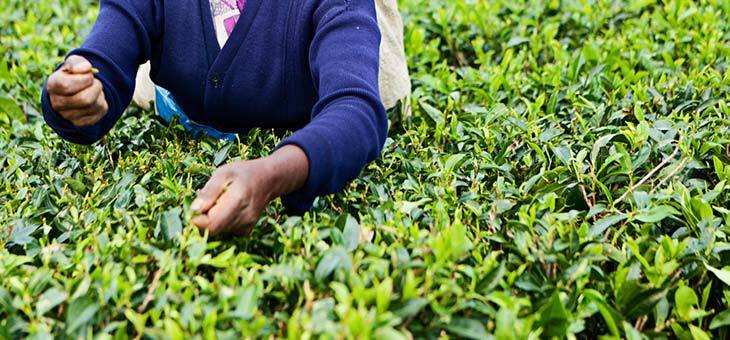After water, tea is still the second most consumed beverage in the world (at around double the quantity of coffee) with an estimated 6 billion cups enjoyed around the world every day.
It is widely acknowledged that the plant is native to China and tea making there has been dated as having first taken place over 3000 years ago. The word ‘Tcha’ or ‘Cha’, traditionally used as a colloquialism for tea, is of Chinese origin.
All tea is made from the leaves of the camelia sinensis plant and commercial scale production of tea takes place across various countries including Kenya, Sri Lanka, India, Japan and China.
Like any plant grown and harvested for consumption, the local climate, soil and many other factors affect the flavour that ends up in your cup.
There are two main types of tea – black and green. Both are harvested from the Camaelia Sinensis plant, however they are two different varieties: Cameilia Sinenesis var. assamica and var. sinensis respectively.
The former is predominantly used for producing green teas, with the latter for black teas. Within the black tea sector there are an additional three categories – Oolong, Pu-erh and White (yes, white from black is a contradiction but I will explain later), all of these are also from the var. assamica.
All teas are harvested in the same manner. The bushes are allowed to grow to around waist height and only the fresh buds and adjoining few leaves are picked, or plucked to use the industry term. This takes place very early in the morning before the heat of the day.
Processing
Having explained the varietal distinctions of tea, now we’ll look at the different ways these varieties are processed.
The processing stages for all true black teas are the same:
- Withering: The leaves are laid out in the sun to wilt and soften over several hours. Alternatively hot air may be blown across them.
- Rolling: Once wilted, the leaves are pressed or rolled to extract the juices. In doing so, the leaf’s cell walls are broken, allowing oxidation to commence.
- Oxidation: Again the leaves are laid out to aid the oxidation process to take place. Sometimes the term ‘fermentation’ is used for this stage, however technically fermentation in the real sense does not take place.
- Firing: The leaves are now heated to remove almost all remaining moisture and prevent further oxidation. It is this stage where the leaves take on their dark brown to black colouring.
-
Grading: Also called sorting, the leaves are passed through sieves to provide the various grades from whole leaf down to dust.
This method may be used to create such teas as English Breakfast, Darjeeling or Earl Grey.
When green tea is processed, after withering it is steamed (and in some cases pan-fried), then rolled, dried and graded. Essentially the oxidation step is removed.
Matcha tea is lightly steamed and after drying, stone-ground into a fine powder. This powder is mixed into the brewing water, so a cup of Matcha tea actually contains the ground leaves, as opposed to any other tea where the leaves re-steeped then removed from the water before consuming the brew.
As a result, it retains more of the beneficial components when compared to standard green tea where you discard the leaves, and it contains higher levels of caffeine too.
Pu-erh can be produced in a variety of forms, from raw to fully fermented. As a raw product it is aged and allowed to slowly ferment over time, whereas if fully fermented it has undergone a modern fast fermenting process. Traditionally the raw version was sometimes formed into compressed shapes. This meant a larger quantity could more easily be carried when traversing the country and was even used as a currency.
By comparison, Oolong tea is oxidised, but only partially. Then there is White tea, which is very much a specialty tea. It is relatively rare as it is picked before the white buds have opened fully.
Although it is called white tea, it has a greenish hue, so it looks similar to green tea, but like Oolong it is partially oxidised, providing a less grassy, smoother flavour. Because of this reduced processing, it retains the most antioxidants and the least bio-available caffeine. Traditionally white tea was reserved for Chinese nobility.
Caffeine in tea
So, we can understand that despite the many differences between tea and coffee, one similarity that they share is that they do both contain caffeine, though tea generally has a reduced level compared to coffee.
Depending on whose research you consult, black tea can come in at around a quarter of the content, while green tea can be as low as half. Variances in these levels can be influenced by brew time, ratio of water to leaves and whether you top the pot up.
Many ‘teas’ available today don’t actually contain any tea, meaning that they are technically misnamed, as they should be called infusions or tisanes, which simply means that the drink does not contain any caffeine.
These drinks can be made with herbs, fruits, plant leaves etc. and are steeped the same way as tea. Tisanes and infusions should not be confused with flavoured teas, which are made with leaf tea and the addition of a flavouring – think Earl Grey with its rose petals and oil of bergamot or even the smokey Russian Caravan.
Other alternatives include:
- Rooibos: called tea but it too contains no caffeine and is also very low in tannin. It is made from a plant of the legume family which is native to the Western Cape of South Africa.
- Mate / Yerba Mate: traditionally made by steeping the whole leaves in the cup. Per cup it actually contains around the same quantity of caffeine as coffee.
One other big advantage of tea is its shelf-life. Kept in the correct conditions, this can be up to two or three years!


